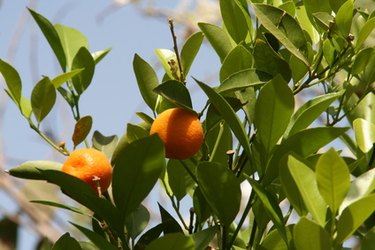
Orange trees are tropical fruit plants that are grown in backyard landscapes as well as in orchards for commercial production. They are fairly disease resistant, although they are more susceptible to dying in colder temperatures. In the United States, orange trees are grown mostly in Florida, but also appear in California, Arizona, Louisiana, Texas, Alabama, Mississippi and Georgia, according to Purdue University. Look for a few identifying signs if you have orange trees that you suspect are dead.
Step 1
Wait to examine the tree until the warm season months, since this is when any growth will be visible. If you think the orange tree is dead during winter, continue caring for it until spring when you can more easily determine whether it is truly dead.
Video of the Day
Step 2
Look at the limbs of the orange tree and see if it has any green leaves. If there are no green leaves, the tree is dead. However, if you see green leaves--even if they are sparse--then the orange tree may be sick, but it is not completely dead.
Step 3
Examine the ends of the branches for tiny buds that are approximately 1/4 inch long. During the spring, these buds will turn green as they prepare to open into leaves. If you do not see any buds, or if the buds are black or brown, then the orange tree is dead.
Step 4
Cut off one of the smaller branches--using a hand saw--approximately 1 inch from where it emerges from the orange tree trunk. Examine the interior wood of the branch you cut to see if it is yellow or white and moist to the touch. If the wood is brown, black or completely dry, then the orange tree is dead.
Step 5
Examine the ground underneath the tree for more than one or two broken limbs and branches. Once an orange tree starts to die, the branches dry out and they break off easily.
Video of the Day